| Better
Living Through Knitting Technology
Like many men, I
am predisposed to purchase every gadget,
gizmo, device and toy that I can possibly
rationalize in my discussions with
my wallet, my creditors and my increasingly
skeptical significant other. I can't
just have one video game console if
four (plus a computer and a laptop)
will do. I can't have a cellphone
that just makes phone calls -- as
if those even exist anymore. iPod?
Check. Digital camcorder? Check. Wireless
internet? Check. HD PVR? Check and
double-check.
Knitting is the
one place in my life that has been
relatively gadget-free. There just
aren't that many sexy devices for
your average knitter. (Spinners and
weavers, on the other hand, are swimming
in them.) So it is with a particularly
heavy heart that I must admit to all
of you that I am the owner of a Bond
Ultimate Sweater Machine (As Seen
on TV).
The Name is Bond
For those of you
unacquainted with it, the Bond is
a relatively inexpensive plastic bulky-weight
hand knitting machine designed for
hobbyists, occasional users and for
those of us who are prone to Knitting
Emergencies. It costs a few hundred
dollars if you shop around, which
stands in stark comparison to the
$1,000+ you'd pay for a more sophisticated
punch card or electronic machine.
If you browse around the internet,
you'll find the machine has a small
but loyal fan base who are eager to
share their tips and tricks on getting
the most (and the most knitting) out
of your new purchase.
Let me be the first
to say that, as an entry-level knitting
machine, the Bond works exactly the
way it's supposed to, and does exactly
what the company says it does. However,
there are some significant differences
between knitting by hand and knitting
by machine, and there is a definite
unavoidable learning curve. (Some
people say that it's actually easier
to knit with a machine if you've never
hand-knitted before.) Bond's promotional
materials are correct when they tell
you that you can knit an entire sweater
with their knitting machine in less
than three days. What you'll discover
for yourself, though, is that those
three days will probably arrive quite
some time after you first set it up.
The Bionic Knitter
Let's be honest:
with the holidays hurtling toward
us like a fast-moving train, which
knitter among us has not lain awake
at night -- particularly in the latter
half of November -- wondering if a knitting
machine would help us speed through
the many gifts we are racing to complete?
Wonder no more --
the answer is a qualified "yes".
With practice, you can knit 600 to
1,200 stitches per minute (uh huh,
you read right) and about 20 inches
of knitted fabric, 100 stiches wide,
in about five minutes -- but before
you run screaming into the street
to buy one, you might want to take
a few moments to find out what this
process entails.
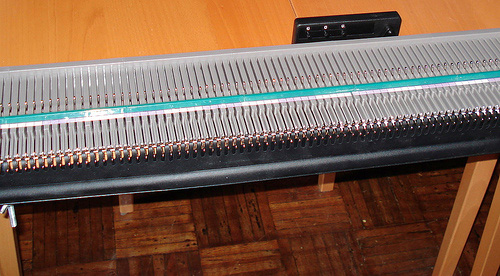
The standard garden-variety
knitting machine consists of a bed of latch
hooks that function as needles, and a carriage
that you pass back and forth along the needles
to supply them with yarn to create the fabric.
The hooks grab the yarn as the carriage passes,
and then pull it through the loops that were
previously created. The old loops drop down
and then the carriage passes again, prompting
the hooks to grab the yarn -- and the process
repeats. This ends up feeling much more like
weaving than knitting. If you enjoy working
a loom (or if you enjoy ironing), you'll feel
right at home.
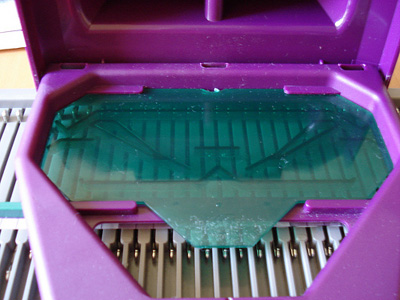  Each
machine uses a different method to simulate
the needle size and gauge that we associate
with hand knitting; in the case of the Bond,
plastic keyplates are inserted into the carriage
to create longer or shorter paths for the needles
to travel -- the longer the path, the larger
the stitch. Each
machine uses a different method to simulate
the needle size and gauge that we associate
with hand knitting; in the case of the Bond,
plastic keyplates are inserted into the carriage
to create longer or shorter paths for the needles
to travel -- the longer the path, the larger
the stitch.
The bottom edge of the work
is weighted with a detachable hem so that the
fabric pulls cleanly and evenly off the machine
and a consistent tension is maintained. The
result is row upon row of eerily perfect stockinette
stitch.
I Sense a 'But' Coming.
You're right, there's
a 'but'. Several of them, actually.
Let's take a few minutes to check
out some 'but's (because that's just
the kind of guy I am).
When looking at the pros and
cons of machine knitting, let's face it: row
upon row of eerily perfect stockinette stitch
is quite a pro. But. As we all know, there's
much more to knitting than stockinette -- and
every other stitch combination is something
of a challenge to achieve on a knitting machine.
Many machines have a variety of attachments
and devices available for techniques like ribbing,
intarsia, fair isle, cables, garter stitch (yes,
garter stitch), circular knitting and so on.
But. They all come off as complicated solutions
to situations that hand knitters would normally
consider to be relatively straightforward.
The Bond is among the simplest
and least sophisticated of knitting machines,
so in many cases you need to manipulate the
stitches by hand (usually by unhooking and rehooking
stitches) in order to achieve whatever effects
you want. This can be absorbing, interesting
instructive and enjoyable. But. It can also
be time-consuming, frustrating and tedious --
and sometimes even slower than if you had just
whipped out the old pointy sticks in the first
place.
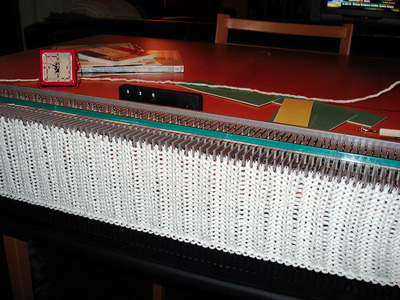  It's
also worth noting that your machine knitting
is limited in width to the number of latch-hooks
across the width of your machine. Most needle
beds look quite wide. But. They are deceptive
-- the maximum number of stitches on the Bond
without an extension is about 100 stittches.
If you need more stitches for your pattern (say,
for an afghan), you need to add more hooks through
an extension to your needle bed, or you need
to divide your pattern into sections and seam
them together after. It's
also worth noting that your machine knitting
is limited in width to the number of latch-hooks
across the width of your machine. Most needle
beds look quite wide. But. They are deceptive
-- the maximum number of stitches on the Bond
without an extension is about 100 stittches.
If you need more stitches for your pattern (say,
for an afghan), you need to add more hooks through
an extension to your needle bed, or you need
to divide your pattern into sections and seam
them together after.
Given that the latch-hooks
on the needle bed are a fixed width
apart from each other, and the different
gauges are standardized through keyplates
or carriage adjustments, you'd think
that machine knitting would be something
of an exact science. But. It's not.
A scarf knit 40 stitches wide for
650 rows on a pair of regular knitting
needles will be neither the same length
nor the same width as a similar scarf
knit on a knitting machine set at
the same needle size and gauge. Seriously,
you can't imagine how different they
will be. So here's one thing you'll
be doing a lot of: swatching. In fact
it's safe to say that you cannot knit
anything on a machine with any serious
expectation of its length or width
unless you swatch first. And not just
swatch -- you have to wash and block
as well. This is not an option. In
my experience, knitted fabric fresh
off the machine is often tighter and
shorter than my hand knitting, even
when I move up one or two needle sizes
to compensate. Thankfully, you can
knit up a very large swatch on a knitting
machine very quickly -- no more of
this 'four inch by four inch' nonsense
-- and consequently make more accurate
adjustments to whatever pattern you're
working on.
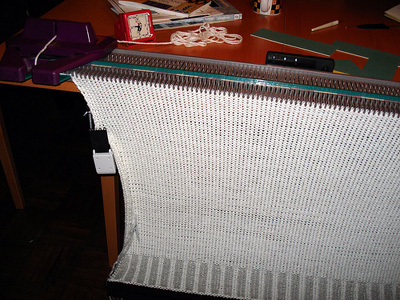  As
well, different machines are designed to handle
different weights of yarn. A bulky-weight machine
may not be able to handle anything lighter than
sport yarn, and a finer-weight machine may have
trouble knitting worsted. The Bond is a bulky-weight
machine, which is great for making sweaters
but not so much when it comes to baby clothes.
Make sure you know what you're machine can and
cannot do before you buy it. As
well, different machines are designed to handle
different weights of yarn. A bulky-weight machine
may not be able to handle anything lighter than
sport yarn, and a finer-weight machine may have
trouble knitting worsted. The Bond is a bulky-weight
machine, which is great for making sweaters
but not so much when it comes to baby clothes.
Make sure you know what you're machine can and
cannot do before you buy it.
Some other important considerations:
hand knitting is quiet, portable, meditative
and generally requires very little set-up: just
cast on and go. But. Machine knitting is noisy
(Say "clack-clack-clack-clack-clack"
as fast as you can. Louder. Faster. Louder.
Faster. There you go.), it's pretty much fixed
to one location, and it can take anywhere from
five to twenty minutes to assemble and prepare.
And meditative is the last word I would use
to describe it. On a good day, it's fabulously
productive; on a bad day, it's a terrific way
to simulate a third-world sweatshop in your
very own home.
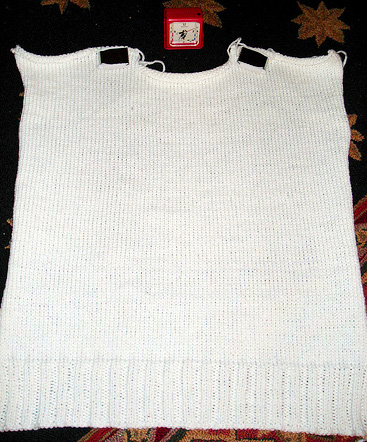  In
conclusion... In
conclusion...
Some of those buts
are very big. But. Don't let them
dissuade you from giving machine knitting
a try. Many of the finer yarn stores,
as well as sewing machine stores and
some of the larger craft stores, have
knitting machines set up and ready
for demonstrations. Some of these
same stores also give lessons or hold
workshops to teach you how to operate
and maintain your machine, how to
follow patterns written specifically
for machine knitting and how to adapt
hand knitting patterns so that you
can make whatever item you choose.
Also keep in mind
that you can easily move machine-knit
fabric onto (sometimes long, frequently
circular) knitting needles and finish
it by hand. This is particularly good
for ribbing or for certain increases
and decreases. It is, however, incredibly
difficult to move hand knitting -- no
matter how loose, stretchy or flexible -- onto
a knitting machine. Believe me, I've
tried.
While I do about 95% of my
knitting by hand, I am glad that I have my Bond
to fall back on -- and so are a number of my
holiday gift recipients, whether or not they
realize it.
Now, if you'll excuse me,
I'll be heading off to my next challenge: comparing
the virtues of the Ashford Joy to those of the
Louet S45. Best wishes, and have a Happy 2007! |

